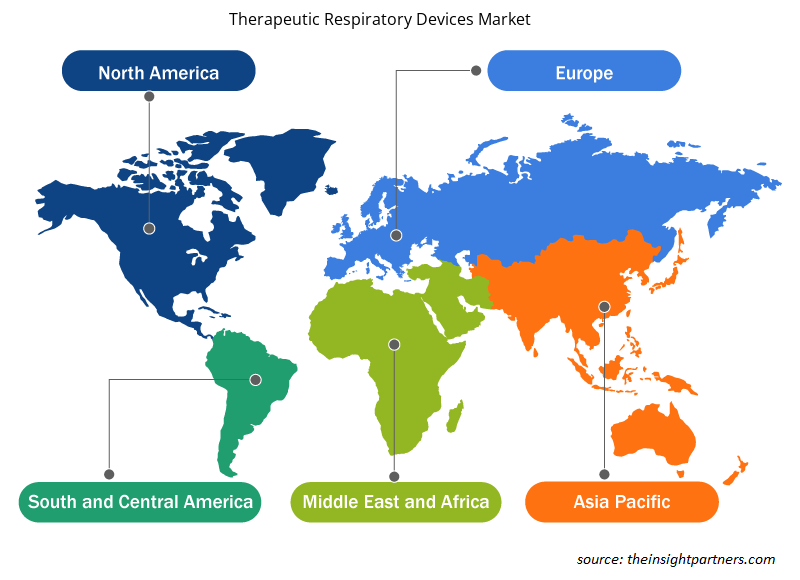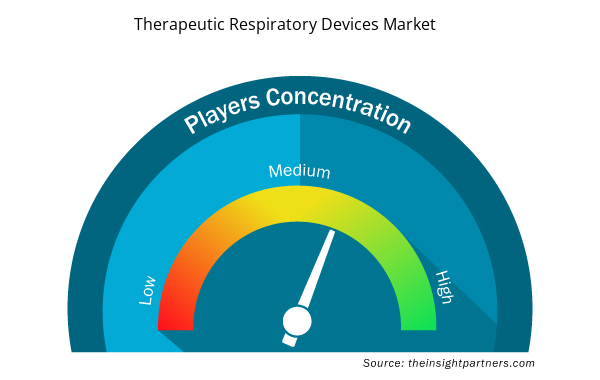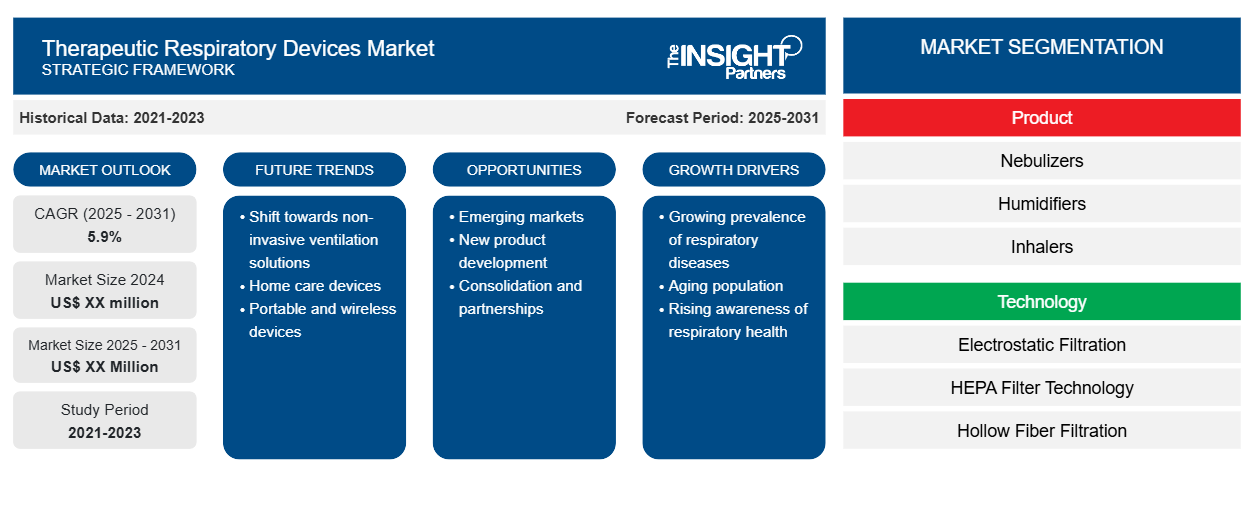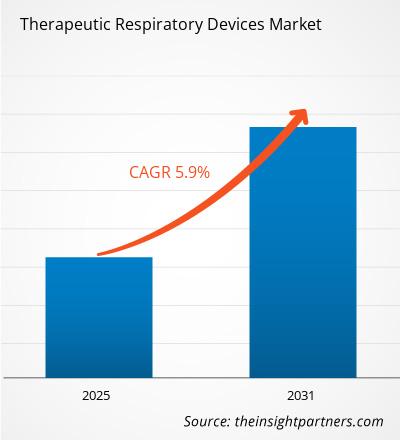Der Markt für therapeutische Beatmungsgeräte wird voraussichtlich von 2024 bis 2031 eine durchschnittliche jährliche Wachstumsrate (CAGR) von 5,9 % verzeichnen, wobei die Marktgröße von XX Millionen US-Dollar im Jahr 2024 auf XX Millionen US-Dollar im Jahr 2031 wachsen wird.
Der Bericht ist segmentiert nach Produkt (Vernebler, Luftbefeuchter, Inhalatoren, Sauerstoffkonzentratoren, Geräte mit positivem Atemwegsdruck, Beatmungsgeräte, Kapnographen, Gasanalysatoren und andere); Technologie (Elektrostatische Filtration, HEPA-Filtertechnologie, Hohlfaserfiltration und Mikrosphärentrennung), Filter (Verneblerfilter, Luftbefeuchterfilter, Filter für Geräte mit positivem Atemwegsdruck, Sauerstoffkonzentratorfilter und Beatmungsfilter)
Zweck des Berichts
Der Bericht „Markt für therapeutische Atemgeräte“ von The Insight Partners soll die aktuelle Situation und das zukünftige Wachstum sowie die wichtigsten treibenden Faktoren, Herausforderungen und Chancen beschreiben. Dies wird verschiedenen Geschäftspartnern Einblicke geben, wie zum Beispiel:
- Technologieanbieter/-hersteller: Um die sich entwickelnde Marktdynamik zu verstehen und die potenziellen Wachstumschancen zu kennen, damit sie fundierte strategische Entscheidungen treffen können.
- Investoren: Durchführung einer umfassenden Trendanalyse hinsichtlich der Marktwachstumsrate, der finanziellen Marktprognosen und der Chancen entlang der Wertschöpfungskette.
- Regulierungsbehörden: Zur Regulierung von Richtlinien und Überwachungsaktivitäten auf dem Markt mit dem Ziel, Missbrauch zu minimieren, das Vertrauen der Anleger zu bewahren und die Integrität und Stabilität des Marktes aufrechtzuerhalten.
Therapeutische Beatmungsgeräte Marktsegmentierung
Produkt
- Vernebler
- Luftbefeuchter
- Inhalatoren
- Sauerstoffkonzentratoren
- Geräte zur positiven Atemwegsdruckregelung
- Ventilatoren
- Kapnographen
- Gasanalysatoren
- Sonstiges
Technologie
- Elektrostatische Filtration
- HEPA-Filtertechnologie
- Hohlfaserfiltration
- Mikrokügelchentrennung
Filter
- Verneblerfilter
- Luftbefeuchterfilter
- Filter für Geräte mit positivem Atemwegsdruck
- Sauerstoffkonzentratorfilter
- Ventilatorfilter
Geographie
- Nordamerika
- Europa
- Asien-Pazifik
- Süd- und Mittelamerika
- Naher Osten und Afrika
Passen Sie diesen Bericht Ihren Anforderungen an
Sie erhalten kostenlos individuelle Anpassungen an jedem Bericht, einschließlich Teilen dieses Berichts oder einer Analyse auf Länderebene, eines Excel-Datenpakets sowie tolle Angebote und Rabatte für Start-ups und Universitäten.
- Holen Sie sich die wichtigsten Markttrends aus diesem Bericht.Dieses KOSTENLOSE Beispiel umfasst eine Datenanalyse von Markttrends bis hin zu Schätzungen und Prognosen.
Wachstumstreiber auf dem Markt für therapeutische Beatmungsgeräte
- Zunehmende Verbreitung von Atemwegserkrankungen:
- Die rasch steigende Zahl von Atemwegserkrankungen wie chronisch obstruktiver Lungenerkrankung (COPD), chronischer Bronchitis und Asthma wird den Markt für therapeutische Atemhilfen antreiben. Laut Angaben der Weltgesundheitsorganisation ist COPD für drei Millionen Todesfälle pro Jahr verantwortlich und damit die dritthäufigste Todesursache weltweit. Rund 65 Millionen Menschen leiden an dieser Krankheit. Die steigende Zahl von Atemwegserkrankungen wird diesen Markt voraussichtlich antreiben.
- Alternde Bevölkerung:
- Der andere wichtige Impulsgeber für den Markt für therapeutische Atemgeräte ist das Alter. Mit zunehmendem Alter leiden Menschen häufiger an Lungenerkrankungen wie COPD, die schließlich zu chronischem Atemversagen führen können. Schätzungen zufolge werden im Jahr 2050 fast 1,5 Milliarden Menschen 65 Jahre und älter sein und daher therapeutische Atemgeräte benötigen, um chronische Atemwegserkrankungen besser behandeln zu können.
- Steigendes Bewusstsein für die Gesundheit der Atemwege:
- Das wachsende Bewusstsein der Menschen für die Gesundheit der Atemwege treibt auch den Markt für therapeutische Beatmungsgeräte an. Das Bewusstsein für die Lungengesundheit und die Notwendigkeit, Krankheiten frühzeitig zu erkennen, führt zu einem wachsenden Bewusstsein für eine frühzeitige medizinische Versorgung und erhöht somit die Nachfrage nach therapeutischen Beatmungsgeräten. Ein wachsendes Bewusstsein in diesem Bereich führt auch zur Einführung von Geräten für die häusliche Pflege und nicht-invasiven Beatmungslösungen, die einfachere und kostengünstigere Behandlungsmöglichkeiten bieten.
Zukünftige Trends auf dem Markt für therapeutische Beatmungsgeräte
- Umstellung auf nicht-invasive Beatmungslösungen:
- Der Trend zu NIV-Lösungen nimmt auf dem Markt für therapeutische Beatmungsgeräte rasant zu. Dies liegt vor allem daran, dass die mit NIV verbundenen Komplikationen geringer sind; es verbessert die Behandlungsergebnisse der Patienten, reduziert Krankenhausaufenthalte und kann Intubationen so weit wie möglich vermeiden. Dieser Trend wird durch den technologischen Fortschritt, die zunehmende Einführung nichtinvasiver Beatmungstherapien und das wachsende Bewusstsein für die Vorteile von NIV bei allen Gesundheitsdienstleistern und Patienten vorangetrieben.
- Geräte für die häusliche Pflege:
- Ein weiterer Trend und ein Thema auf dem Markt für therapeutische Beatmungsgeräte in den letzten Jahren sind Geräte für die häusliche Pflege. Dies ist hauptsächlich auf das zunehmende Bewusstsein für eine wirtschaftliche und patientenorientierte Pflege zurückzuführen. Dies hat zu einer steigenden Nachfrage nach Geräten für die häusliche Pflege geführt, da Patienten alle erforderlichen Behandlungen zu Hause erhalten und Krankenhausaufenthalte und andere Kosten vermeiden können, während gleichzeitig der Patientenkomfort verbessert wird. Darüber hinaus sind sie bequemer und flexibler, sodass Patienten ihre Atemwegserkrankungen besser in den Griff bekommen.
- Tragbare und drahtlose Geräte:
- Tragbare und kabellose Geräte sind der neueste Trend bei therapeutischen Atemgeräten. Solche Geräte ermöglichen es Patienten, während der Behandlung mobil zu sein, um ihr allgemeines Wohlbefinden zu steigern und sogar die Morbidität zu senken. Mit der kabellosen Technologie kann die Überwachung aus der Ferne erfolgen und die Daten können zur Beurteilung an den Gesundheitsdienstleister übermittelt werden, um basierend auf der Reaktion des Patienten Behandlungsentscheidungen zu treffen. Dies ist auf den technologischen Fortschritt, die steigenden Ansprüche der Patienten an Mobilität und Komfort sowie das wachsende Wissen über die Vorteile zurückzuführen, die die kabellose Überwachung den Patienten bringen kann.
Marktchancen für therapeutische Beatmungsgeräte
- Schwellenmärkte:
- Schwellenmärkte sorgen für erhebliches Wachstum auf dem Markt für therapeutische Beatmungsgeräte. Mehrere Länder, darunter China, Indien und Brasilien, verzeichnen ein hohes Wirtschaftswachstum und steigende Gesundheitsausgaben, was zwangsläufig die Nachfrage nach Beatmungsgeräten erhöhen wird. Schwellenmärkte bieten Möglichkeiten für die Entwicklung neuer Produkte, die Ausweitung der Präsenz und die Erschließung weitgehend unerschlossener Märkte.
- Neue Produktentwicklung:
- Fortschritte bei der Entwicklung neuer Produkte und Technologien Die Einführung neuer Produkte und Technologien bietet Unternehmen die Möglichkeit, sich auf dem Markt zu differenzieren. Dank Werkstofftechnik, Sensortechnologie und künstlicher Intelligenz entwickeln Wissenschaftler bessere Geräte. Die Entwicklung neuer Produkte kann einem Unternehmen dabei helfen, seine Konkurrenten zu übertreffen, indem es die Behandlungsergebnisse verbessert und gleichzeitig den Umsatz steigert.
- Konsolidierung und Partnerschaften:
- Der Markt für therapeutische Beatmungsgeräte kann auch durch Konsolidierung und Partnerschaften wachsen. Unternehmen in der Branche profitieren von diesen Partnerschaften, Kooperationen und Übernahmen, da sie aggressiver wachsen und versuchen, starke Marktanteile zu erringen. Solche Initiativen ermöglichen es Unternehmen, Ressourcen, Know-how und sogar Risiken zu bündeln und so Innovation und Wachstum zu fördern.
Regionale Einblicke in den Markt für therapeutische Beatmungsgeräte
Die regionalen Trends und Faktoren, die den Markt für therapeutische Atemgeräte während des Prognosezeitraums beeinflussen, wurden von den Analysten von Insight Partners ausführlich erläutert. In diesem Abschnitt werden auch Marktsegmente und Geografie für therapeutische Atemgeräte in Nordamerika, Europa, im asiatisch-pazifischen Raum, im Nahen Osten und Afrika sowie in Süd- und Mittelamerika erörtert.

- Erhalten Sie regionale Daten zum Markt für therapeutische Beatmungsgeräte
Umfang des Marktberichts über therapeutische Beatmungsgeräte
| Berichtsattribut | Details |
|---|---|
| Marktgröße im Jahr 2024 | XX Millionen US-Dollar |
| Marktgröße bis 2031 | XX Millionen US-Dollar |
| Globale CAGR (2024 - 2031) | 5,9 % |
| Historische Daten | 2021-2023 |
| Prognosezeitraum | 2025–2031 |
| Abgedeckte Segmente | Nach Produkt
|
| Abgedeckte Regionen und Länder | Nordamerika
|
| Marktführer und wichtige Unternehmensprofile |
|
Marktteilnehmerdichte für therapeutische Beatmungsgeräte: Auswirkungen auf die Geschäftsdynamik verstehen
Der Markt für therapeutische Atemgeräte wächst rasant, angetrieben durch die steigende Nachfrage der Endnutzer aufgrund von Faktoren wie sich entwickelnden Verbraucherpräferenzen, technologischen Fortschritten und einem größeren Bewusstsein für die Vorteile des Produkts. Mit steigender Nachfrage erweitern Unternehmen ihr Angebot, entwickeln Innovationen, um die Bedürfnisse der Verbraucher zu erfüllen, und nutzen neue Trends, was das Marktwachstum weiter ankurbelt.
Die Marktteilnehmerdichte bezieht sich auf die Verteilung von Firmen oder Unternehmen, die in einem bestimmten Markt oder einer bestimmten Branche tätig sind. Sie gibt an, wie viele Wettbewerber (Marktteilnehmer) in einem bestimmten Marktraum im Verhältnis zu seiner Größe oder seinem gesamten Marktwert präsent sind.
Die wichtigsten auf dem Markt für therapeutische Beatmungsgeräte tätigen Unternehmen sind:
- AstraZeneca
- 3M
- Koninklijke Philips NV
- Allgemeine Elektrik
- GlaxoSmithKline plc.
Haftungsausschluss : Die oben aufgeführten Unternehmen sind nicht in einer bestimmten Reihenfolge aufgeführt.

- Überblick über die wichtigsten Akteure auf dem Markt für therapeutische Beatmungsgeräte
Wichtige Verkaufsargumente
- Umfassende Abdeckung: Der Bericht deckt die Analyse von Produkten, Dienstleistungen, Typen und Endbenutzern des Marktes für therapeutische Beatmungsgeräte umfassend ab und bietet einen ganzheitlichen Überblick.
- Expertenanalyse: Der Bericht basiert auf dem umfassenden Verständnis von Branchenexperten und Analysten.
- Aktuelle Informationen: Der Bericht stellt durch die Abdeckung aktueller Informationen und Datentrends Geschäftsrelevanz sicher.
- Anpassungsoptionen: Dieser Bericht kann angepasst werden, um spezifische Kundenanforderungen zu erfüllen und die Geschäftsstrategien optimal anzupassen.
Der Forschungsbericht zum Markt für therapeutische Atemgeräte kann daher dabei helfen, die Branchensituation und Wachstumsaussichten zu entschlüsseln und zu verstehen. Obwohl es einige berechtigte Bedenken geben kann, überwiegen die allgemeinen Vorteile dieses Berichts tendenziell die Nachteile.
- Historische Analyse (2 Jahre), Basisjahr, Prognose (7 Jahre) mit CAGR
- PEST- und SWOT-Analyse
- Marktgröße Wert/Volumen – Global, Regional, Land
- Branche und Wettbewerbsumfeld
- Excel-Datensatz



Report Coverage
Revenue forecast, Company Analysis, Industry landscape, Growth factors, and Trends

Segment Covered
This text is related
to segments covered.

Regional Scope
North America, Europe, Asia Pacific, Middle East & Africa, South & Central America

Country Scope
This text is related
to country scope.
Häufig gestellte Fragen
The therapeutic respiratory devices market is estimated to grow with a CAGR of 5.9% from 2023 to 2031.
Asia Pacific region is likely to witness fastest growth rate during the forecast period.
The market drivers include growing prevalence of respiratory diseases and aging population are driving the therapeutic respiratory devices market
The therapeutic respiratory devices market majorly consists of the players such as AstraZeneca, 3M, Koninklijke Philips N.V. among others.
Shift towards non-invasive ventilation solutions are likely to remain the key trend during the forecast period
North America dominated the therapeutic respiratory devices market in 2023
Trends and growth analysis reports related to Life Sciences : READ MORE..
1. AstraZeneca
2. 3M
3. Koninklijke Philips N.V.
4. General Electric
5. GlaxoSmithKline plc.
6. MEDTRONIC
7. Chart Industries
8. ResMed
9. Fisher & Paykel Healthcare Limited.
10. BD
The Insight Partners performs research in 4 major stages: Data Collection & Secondary Research, Primary Research, Data Analysis and Data Triangulation & Final Review.
- Data Collection and Secondary Research:
As a market research and consulting firm operating from a decade, we have published and advised several client across the globe. First step for any study will start with an assessment of currently available data and insights from existing reports. Further, historical and current market information is collected from Investor Presentations, Annual Reports, SEC Filings, etc., and other information related to company’s performance and market positioning are gathered from Paid Databases (Factiva, Hoovers, and Reuters) and various other publications available in public domain.
Several associations trade associates, technical forums, institutes, societies and organization are accessed to gain technical as well as market related insights through their publications such as research papers, blogs and press releases related to the studies are referred to get cues about the market. Further, white papers, journals, magazines, and other news articles published in last 3 years are scrutinized and analyzed to understand the current market trends.
- Primary Research:
The primarily interview analysis comprise of data obtained from industry participants interview and answers to survey questions gathered by in-house primary team.
For primary research, interviews are conducted with industry experts/CEOs/Marketing Managers/VPs/Subject Matter Experts from both demand and supply side to get a 360-degree view of the market. The primary team conducts several interviews based on the complexity of the markets to understand the various market trends and dynamics which makes research more credible and precise.
A typical research interview fulfils the following functions:
- Provides first-hand information on the market size, market trends, growth trends, competitive landscape, and outlook
- Validates and strengthens in-house secondary research findings
- Develops the analysis team’s expertise and market understanding
Primary research involves email interactions and telephone interviews for each market, category, segment, and sub-segment across geographies. The participants who typically take part in such a process include, but are not limited to:
- Industry participants: VPs, business development managers, market intelligence managers and national sales managers
- Outside experts: Valuation experts, research analysts and key opinion leaders specializing in the electronics and semiconductor industry.
Below is the breakup of our primary respondents by company, designation, and region:

Once we receive the confirmation from primary research sources or primary respondents, we finalize the base year market estimation and forecast the data as per the macroeconomic and microeconomic factors assessed during data collection.
- Data Analysis:
Once data is validated through both secondary as well as primary respondents, we finalize the market estimations by hypothesis formulation and factor analysis at regional and country level.
- Macro-Economic Factor Analysis:
We analyse macroeconomic indicators such the gross domestic product (GDP), increase in the demand for goods and services across industries, technological advancement, regional economic growth, governmental policies, the influence of COVID-19, PEST analysis, and other aspects. This analysis aids in setting benchmarks for various nations/regions and approximating market splits. Additionally, the general trend of the aforementioned components aid in determining the market's development possibilities.
- Country Level Data:
Various factors that are especially aligned to the country are taken into account to determine the market size for a certain area and country, including the presence of vendors, such as headquarters and offices, the country's GDP, demand patterns, and industry growth. To comprehend the market dynamics for the nation, a number of growth variables, inhibitors, application areas, and current market trends are researched. The aforementioned elements aid in determining the country's overall market's growth potential.
- Company Profile:
The “Table of Contents” is formulated by listing and analyzing more than 25 - 30 companies operating in the market ecosystem across geographies. However, we profile only 10 companies as a standard practice in our syndicate reports. These 10 companies comprise leading, emerging, and regional players. Nonetheless, our analysis is not restricted to the 10 listed companies, we also analyze other companies present in the market to develop a holistic view and understand the prevailing trends. The “Company Profiles” section in the report covers key facts, business description, products & services, financial information, SWOT analysis, and key developments. The financial information presented is extracted from the annual reports and official documents of the publicly listed companies. Upon collecting the information for the sections of respective companies, we verify them via various primary sources and then compile the data in respective company profiles. The company level information helps us in deriving the base number as well as in forecasting the market size.
- Developing Base Number:
Aggregation of sales statistics (2020-2022) and macro-economic factor, and other secondary and primary research insights are utilized to arrive at base number and related market shares for 2022. The data gaps are identified in this step and relevant market data is analyzed, collected from paid primary interviews or databases. On finalizing the base year market size, forecasts are developed on the basis of macro-economic, industry and market growth factors and company level analysis.
- Data Triangulation and Final Review:
The market findings and base year market size calculations are validated from supply as well as demand side. Demand side validations are based on macro-economic factor analysis and benchmarks for respective regions and countries. In case of supply side validations, revenues of major companies are estimated (in case not available) based on industry benchmark, approximate number of employees, product portfolio, and primary interviews revenues are gathered. Further revenue from target product/service segment is assessed to avoid overshooting of market statistics. In case of heavy deviations between supply and demand side values, all thes steps are repeated to achieve synchronization.
We follow an iterative model, wherein we share our research findings with Subject Matter Experts (SME’s) and Key Opinion Leaders (KOLs) until consensus view of the market is not formulated – this model negates any drastic deviation in the opinions of experts. Only validated and universally acceptable research findings are quoted in our reports.
We have important check points that we use to validate our research findings – which we call – data triangulation, where we validate the information, we generate from secondary sources with primary interviews and then we re-validate with our internal data bases and Subject matter experts. This comprehensive model enables us to deliver high quality, reliable data in shortest possible time.


 Holen Sie sich ein kostenloses Muster für diesen Bericht
Holen Sie sich ein kostenloses Muster für diesen Bericht